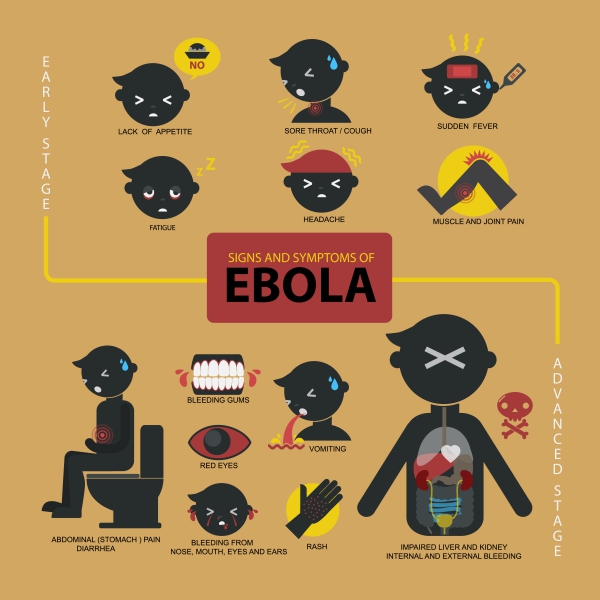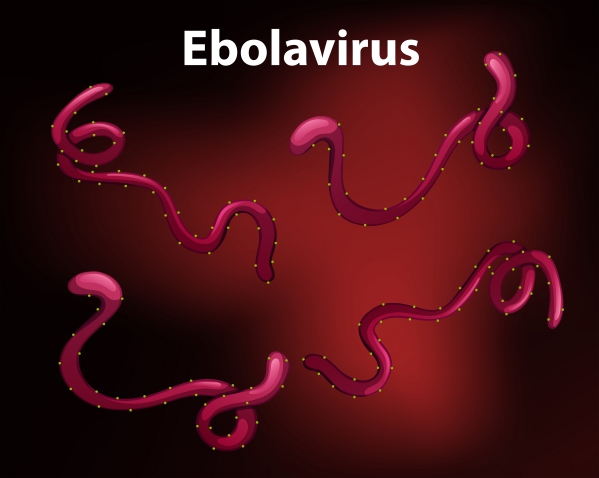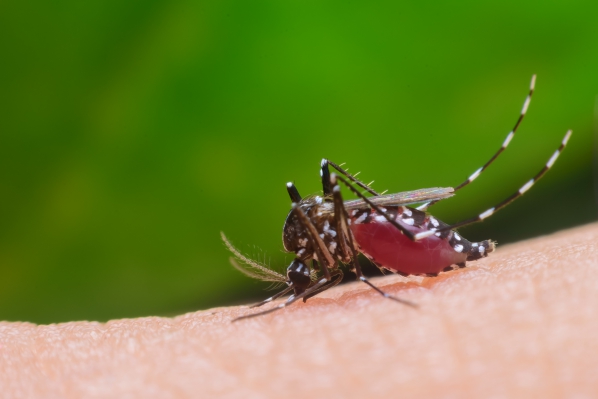What is Ebola virus disease?
Ebola virus disease is a viral infection caused by the Ebola virus which results in a haemorrhagic fever syndrome (associated with severe bleeding). It is one of at least 30 viruses known to cause the same type of fever. It is a serious infection that often results in death. The Ebola virus forms part of the family of viruses known as Filoviridae.
Ebola virus disease is a disease that is common in Africa, mainly, Central Africa, Sudan and West Africa. In 2014, the biggest outbreak aroused in West Africa and lasted till 2016. The areas that were most commonly affected by this outbreak were Guinea, Liberia and Sierra Leone. 80-90% of people affected died from the disease.
Ebola virus causes disease in humans as well as wild animals, more specifically apes. It is thought to be due to contact with bats. This resulted into a decrease in the number of chimpanzees and gorillas in Central Africa. It may also be the reason why outbreaks have started due to humans handling or eating dead animals infected with the virus.

How is Ebola virus transmitted?
Ebola virus can be transmitted the following ways:
- Contact with tissues or body fluids of an infected human or animal. If you have been in contact with a sick or dead person who has the virus, you may catch the disease through direct contact with the infected person’s blood, skin or body fluids. This can happen if the body fluid gets into your mouth or eyes. In West Africa, ritual washing of dead victim’s body has significantly increase the number of infected people.
- Contact with contaminated surfaces or objects. Studies have shown that the virus can remain on surfaces for hours or days.
- Eating undercooked meat of an infected animal.
- You may get Ebola virus disease through sexual contact (oral, anal, vaginal sex) with an infected individual. It can remain in the fluids from the reproductive tract (semen and vaginal fluids) for some time.
- Ebola virus can be transmitted through breastfeeding from an infected mother to her baby.

Ebola virus is not transmitted through the air.
What are the symptoms of Ebola virus disease?
Usually, symptoms of Ebola virus disease begin to appear 6 to 12 days after initial exposure. The symptoms include the following:
- Abrupt onset of fever
- Chills
- Malaise
- Fatigue
- Headache
- Vomiting
- Diarrhoea usually watery
- Loss of appetite
- Weakness
- Muscular pain
- Non-itchy reddish rash over the face, neck, trunk and arms
- Abdominal pain
- Bleeding seen as blood in stools, ecchymosis, persistent bleeding at sites of needle injections or bleeding on the mucosal tissues
The disease may also affect other organ systems such as the neurological, cardiovascular, respiratory or ocular system. This can result in the following symptoms:
- Confusion
- Drowsiness
- Neck stiffness
- Instability when walking
- Seizures
- Decreases heart rate
- Chest pain
- Increased rate of breathing
- Difficulty in breathing
- Blurry vision
- Increased eye sensitivity to bright light
- Loss of vision


How is the diagnosis of Ebola virus disease made?
To make the diagnosis of Ebola virus disease, your doctor will first take a detailed history from you, focusing on estimating your risk of having been exposed to the disease. You are at increased risk of having caught the disease if:
- You have recently travelled to an Ebola-endemic area such as Democratic Republic of the Congo, Sudan, Gabon or Côte d’Ivoire.
- You have been exposed to African tropical forests.
- You have been exposed to infected individuals or animals.
- You are a medical personnel who has been in contact with infected patients.
- You have been in contact with family members who have the disease.
- You have prepared dead bodies of Ebola victims for burial.
- You are an animal care worker who has been in contact with primates.
Your doctor will then proceed with a complete physical examination to look for signs and symptoms of Ebola virus disease.
The following tests may also be requested:

- Basic blood tests: A complete blood count may be requested to check the levels of platelets and white blood cells as these may decrease in the case Ebola virus disease.
- Reverse-tran ion polymerase chain reaction (RT-PCR) assay: This test is used to identify and isolate the virus in the blood hence confirming the diagnosis. However, this is a risky procedure that needs to be performed under strict conditions in specialised laboratories.
How is Ebola virus disease treated?
Once the infected individual is admitted in the hospital (possibly in the intensive care unit -“ICU”), the medical health professionals can provide with supportive treatments to help the body fight and recover from the infection. These treatments also aim to relieve symptoms and make you as comfortable as possible.
You may be receiving fluids from intravenous routes in order to replete your lost body fluids through vomiting, diarrhoea and bleeding. Other medications may be administered to support the blood pressure and to help your blood clot normally. A new medication has been approved by the US Food and Drug Administration (FDA) for the treatment of Ebola virus disease. It is a combination of 3 drugs namely Altoltivimab/maftivimab/odesivimab.
In general, the treatment for Ebola is supportive.
How can Ebola virus disease be prevented?
There is a vaccine that is available for people at increased risk of catching the infection. It is also important to stay away from people who has the disease or those who may have been in contact with infected individuals. Do not have sex with someone who has the disease as it can be transmitted through sexual contact. It is recommended to regularly wash your hands thoroughly with soap and water and wear protective gear if you are exposed to the disease. Dead people with Ebola should be handled with appropriate protective equipment to avoid transmission. Avoid contact with bats, monkeys and apes if you live in an Ebola-endemic area.

Complications of Ebola virus disease
15% of people with the disease ended up with ocular complications. These include eye pain, increased sensitivity to bright light, increased watering of the eyes and decreased vision. The following manifestations are also late complications that may arise from Ebola virus disease:
- Generalised body pain
- Joint pain
- Headache
- Fatigue and weakness
- Eating disorder, more specifically, bulimia
- Menstrual cycle disturbances
- Persistent ringing sound in the ears
- Inflammation of the testis known as Orchitis
Prognosis
In general, the prognosis of Ebola virus disease is poor. The most lethal species of Ebola virus is associated with a mortality rate of 89%.
Source:
Bray, M., 2020. Epidemiology and pathogenesis of Ebola virus disease
Chertow, D., 2020. Clinical manifestations and diagnosis of Ebola virus disease
Chertow, D., 2020. Treatment and prevention of Ebola virus disease



